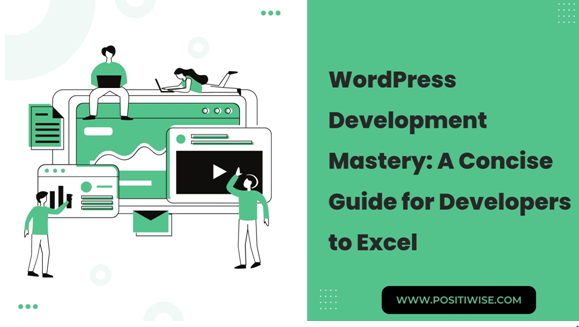WordPress, a robust Content Management System (CMS), powers a whopping 50% of websites worldwide. Underpinning its popularity is the platform’s remarkable versatility and flexibility, offering endless opportunities to build and manage a variety of websites across diverse sectors. As a developer, understanding the intricacies of WordPress website development can significantly boost your skills and marketability. This comprehensive guide aims to equip you with the necessary knowledge and tools to master the technical aspects of WordPress development.
1. The Power of WordPress: A Digital Powerhouse
WordPress is more than just an open-source CMS—it’s a revolution in the digital world. Born from the ingenuity of Matt Mullenweg and Mike Little in 2003, WordPress has evolved from a simple blogging tool to a full-fledged CMS that drives half of the world’s websites.
1.1 The Rise of WordPress
The WordPress journey has been one of constant evolution and growth. From its humble beginnings as a tool for bloggers, WordPress has matured into a comprehensive CMS capable of serving a diverse range of applications. It’s this adaptability that has made WordPress a favorite among developers and users alike.
1.2 WordPress: More Than Just a CMS
The true strength of WordPress lies in its simplicity and ease of use. It has democratized the process of website creation, enabling individuals of all skill levels to build and maintain a website. As such, WordPress is more than just a CMS—it’s a platform that empowers everyone to have a voice in the vast digital landscape.
2. The Building Blocks of WordPress: Themes and Plugins
One of the primary reasons behind WordPress’s vast flexibility is the availability of a wide array of themes and plugins. These fundamental elements allow developers to customize their WordPress websites according to their specific needs and preferences.
2.1 Themes: The Aesthetic Backbone of Your WordPress Site
Themes serve as the visual framework of your website, dictating everything from its layout and color scheme to fonts and other design elements. In addition to their aesthetic role, well-designed themes also adhere to best coding practices, ensuring your website is swift, responsive, and SEO-friendly.
2.2 Plugins: Enhancing Your WordPress Site’s Functionality
Plugins, on the other hand, add advanced functionalities to your WordPress site. They are akin to an App Store for your WordPress site, allowing you to install specific features that enhance your website’s capabilities. With over 58,000 free plugins available in the WordPress plugin directory, the possibilities for expanding your site’s functionalities are virtually endless.
3. The WordPress Community: A Vibrant and Supportive Ecosystem
The success of WordPress is not only due to its impressive features and flexibility but also to the vibrant and supportive community that stands behind it. This community is a testament to the spirit of camaraderie, shared learning, and mutual growth that permeates the field of web development.
3.1 A Global Network of WordPress Enthusiasts
The WordPress community spans across continents and time zones, encompassing an extensive network of developers, designers, content creators, marketers, and users. Each member contributes uniquely to the community’s collective wisdom, making it a vast reservoir of knowledge, expertise, and creativity.
3.2 WordCamps: Fostering a Sense of Camaraderie among WordPress Users
One of the most unique aspects of the WordPress community is the large-scale WordCamps—interactive conferences that bring together WordPress enthusiasts worldwide. These events foster a sense of camaraderie and shared passion among WordPress users, further strengthening the community’s bonds.
4. The WordPress Dashboard: Your Site’s Control Center
The WordPress dashboard serves as your command center for managing your site. Its user-friendly interface ensures that managing your website is a smooth and streamlined process, regardless of your technical proficiency.
4.1 Post and Page Management
The WordPress dashboard provides an easy-to-use interface for creating and editing posts and pages. It also offers tools for managing comments, customizing your site’s appearance, managing user roles, and installing and updating plugins.
4.2 User Roles and Permissions
An often overlooked but crucial feature of the WordPress dashboard is its built-in user roles and permissions system. This system allows you to assign specific roles and capabilities to different users on your site, ensuring that each team member has access to the tools they need while protecting sensitive areas of your site from unauthorized access.
5. WordPress.org vs WordPress.com: Choosing the Right Platform
When getting started with WordPress, one of the first decisions you’ll need to make is whether to use WordPress.org or WordPress.com. While both platforms are built on the same robust WordPress foundation, they cater to different needs and scenarios.
5.1 WordPress.org: The Self-Hosted Powerhouse
WordPress.org offers complete control over your site, including the choice of hosting provider, the ability to install any theme or plugin, and the freedom to customize your site to your heart’s content. This makes WordPress.org an ideal choice for users who crave flexibility and control over their website.
5.2 WordPress.com: The Streamlined Solution
On the other hand, WordPress.com offers a more streamlined, hands-off experience. It takes care of the technical side of running a website, such as hosting, security, backups, and updates, allowing you to focus more on creating content and engaging with your audience.
6. The Many Uses of WordPress: Beyond Blogging
While WordPress started as a blogging platform, its functionality has since expanded to cater to a wide range of applications. Today, WordPress can be used to power e-commerce sites, portfolios, business websites, and even non-profit organizations.
6.1 E-Commerce
With powerful plugins like WooCommerce, you can easily transform your WordPress site into a fully functional online store. This includes features for managing product listings, shopping carts, and secure payment processing.
6.2 Portfolios
WordPress is also an excellent tool for creating professional online portfolios. With a variety of portfolio-specific themes and plugins available, you can easily display your work in an elegant and engaging manner.
7. WordPress Security: Prioritizing Safety in Website Development
In the digital landscape, security is paramount. As a WordPress developer, it’s your responsibility to ensure that your site is protected from potential threats. There are several practices that you can adopt to enhance your website’s security, including regular updates, using strong passwords, enabling two-factor authentication, and regular site backups.
7.1 Regular WordPress Updates
Regular updates are your first line of defense against potential security threats. WordPress regularly enhances its security features and fixes known vulnerabilities with each update, fortifying your site’s defense mechanism against potential threats.
7.2 Two-Factor Authentication
Two-factor authentication provides an extra layer of security for your WordPress login, making it much harder for unauthorized users to gain access to your site.
8. Coding Best Practices for WordPress Development
As a WordPress developer, it’s important to adhere to best coding practices. This includes using hooks and APIs correctly, following WordPress Codex guidelines, and writing efficient and clean code.
8.1 WordPress Codex
The WordPress Codex serves as a comprehensive manual for WordPress developers, detailing the correct WordPress coding standards and best practices. It’s an invaluable resource for ensuring that your code is clean, optimized, and consistent with global best practices.
8.2 Writing Efficient and Clean Code
Writing efficient and clean code is a cornerstone of WordPress development Services. This includes using proper indentation, commenting your code, and following naming conventions.
9. Advanced WordPress Themes and Plugins: Taking Your Site to the Next Level
WordPress features a wealth of advanced themes and plugins that can take your website to the next level. These tools offer a level of customization and functionality that goes beyond the basics, enabling you to create a truly unique and dynamic website.
9.1 Advanced Themes
Advanced themes like Elementor, Avada, and Divi offer a wide range of customization options and features that can help you create a stunning and professional website. These themes are designed to be easy to use, even for beginners, and are highly adaptable to suit a wide range of website types and styles.
9.2 Advanced Plugins
Advanced plugins like Yoast SEO, Akismet Anti-Spam, Contact Form 7, W3 Total Cache, and Jetpack can significantly enhance your site’s capabilities. These plugins offer a range of features, from SEO optimization and spam protection to contact form creation and website performance enhancement.
10. Conclusion: The Power of WordPress Development Unleashed
Mastering the technical aspects of WordPress website development can seem daunting, but with the right knowledge and tools, it’s an achievable goal. By understanding the intricacies of themes, plugins, the WordPress dashboard, security, and coding best practices, you can harness the full potential of WordPress to create stunning, secure, and highly functional websites. Remember, as a WordPress developer, you’re not just building websites—you’re shaping the digital landscape, one website at a time.







